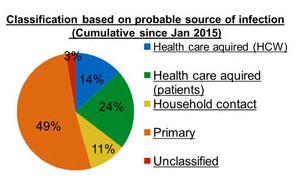#13,067
For the past couple of weeks we've been following what appears to be a modest uptick in (mostly) primary MERS cases across Saudi Arabia, along with an unusually high number of fatalities.
Our last update came on Friday in Saudi MOH: 3 New Primary MERS Cases (Jan 11th), which brought their 2018 total to 12 MERS cases and 8 deaths.
Although the Saudi MOH maintains two (one in Arabic & one in English) daily MERS reports, sometimes - for reasons that aren't usually clear - postings are delayed by a day or two and sometimes entire days are skipped.
A snapshot taken this morning (see below) of the English language surveillance shows two daily reports (3rd & 13th) missing from the first two weeks of 2018.
While it hasn't been posted to the English language list, an entry for the 13th was posted on the Arabic site (see graphic at top of blog), showing 1 new case in Riyadh, along with 3 more fatalities. Since these daily updates are posted in graphical form, regular translation software cannot be used.
Luckily a tweet (in Arabic) overnight from @UDHMED has helped me identify the 3 new fatal cases as the previously announced 72 y.o. male from Gurayat (Jan 11th), a 60 y.o. female from Buraidah (Jan 8th), and a 60 y.o. male from Riyadh (Jan 2nd).
Curiously, the 72 y.o. from Gurayat was listed in stable condition just two days before. This is the third initially-reported-as-stable-but-ultimately-expired case announced by the MOH in the past week.Based on the available reports, during the first 14 days of January, KSA has seen 13 MERS cases (3 have been linked to recent camel exposure, 9 are primary (community acquired), and 1 was a secondary HCW exposure) along with 11 deaths and zero recoveries.
Several of these deaths were in patients infected and announced in late December. Going back a full month (Jan14th-Dec 14th), however, we count 18 Cases and 12 Deaths (66.6%), which is substantially higher than the historical Saudi 40.5% average fatality rate since 2012.
While this is probably a temporary aberation, possibly due to an expected higher overall winter mortality rate, it is a trend we'll be watching.
Also of interest, these 18 cases have all been reported in the last 20 days, and of those 13 are primary (community acquired) - with no listed risk exposure - while 4 had camel exposure. Again a bit of a deviation from what we've seen historically.
Short term trends have a habit of evening out over time, and so we shouldn't make too much of all of this. At least not yet.
If we see a higher mortality rate continue in the months ahead, or a continued increase in the number of community acquired cases, then it may signify somethng of significance.For now, this is simply a short term deviation from the norm; worth noting and keeping an eye on.



